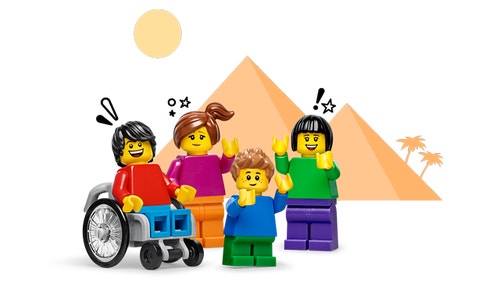SPIKE™ Essential
The Great Desert Adventure
It’s time for another great adventure. Help the team to reach the pyramids!
45-90 min.
Beginner
Years 1-2

Prepare
(NOTE: This lesson will extend over two 45-minute class sessions.)
- Review the Great Desert Adventure lesson in the LEGO® Education SPIKE™ App.
- If you feel that it would be beneficial, pre-teach these related vocabulary words: brainstorm, desert, pyramid, imagine and wonder.
- Consider the abilities and backgrounds of all your pupils. Differentiate the lesson to make it accessible to everyone. Please refer to the Differentiation section below for suggestions on how to do this.
- If time permits, plan and facilitate the language arts extension. Please refer to the Extension section below for more information.
PART A (45 Minutes)
Engage
(Whole Class, 10 Minutes)
- Facilitate a quick discussion about brainstorming and decision-making.
- Talk with your pupils about ways of finding a variety of solutions to solve a problem in your classroom.
- Ask questions like these: Why should you come up with a lot of ideas when trying to solve a problem? Why should you try different ideas?
- Introduce your pupils to the team and the challenge: brainstorming how the team will get to the pyramids.
- Distribute a brick set, any additional brainstorming materials and a device to each group.
Explore
(Small Groups, 25 Minutes)
- Have your pupils use the LEGO® Education SPIKE™ App to guide them through their first challenge:
- Create a way for the team to get to the pyramids. Use at least one motor or sensor (i.e. Colour Sensor or Light).
- Your pupils can brainstorm using the LEGO bricks supplemented with additional materials. Encourage them to think of multiple solutions.
Explain
(Whole Class, 10 Minutes)
- Facilitate a sharing session where your pupils present their initial ideas and provide feedback and suggestions to their peers.
PART B (45 Minutes)
Elaborate
(Small Groups, 30 Minutes)
- Have your pupils build, program and test the prototypes and ideas that they came up with during the brainstorming session in Part A of this lesson.
- Remind them to use at least one motor or sensor.
- Encourage them to test and refine their models and programs over 2-3 iterations.
- You can find coding and building help in the Tips section below.
Evaluate
(Whole Class, 15 Minutes)
- Ask guiding questions to encourage your pupils to ‘think aloud’ and explain their thought processes and reasoning in the decisions they’ve made while building and programming their models.
- Have your pupils tidy up their workstations.
Observation Checklist
- Measure your pupils’ proficiency in applying their computational thinking skills to completing the given task.
- Establish a scale that suits your needs. For example:
- Requires additional support
- Can work independently
- Can teach others
Self-Assessment
Have each pupil choose the brick that they feel best represents their performance.
- Yellow: I think that I can design, build and program a solution.
- Blue: I can design, build and program a solution.
- Green: I can design, build and program a solution, and I can also
help a friend to do it.
Peer Feedback
- In their small groups, have your pupils discuss their experiences working together.
- Encourage them to use statements like these:
- I liked it when you…
- I'd like to hear more about how you…
Tips
Coding Tips
- There are no coding instructions or Inspiration Coding Blocks for this lesson.
- Encourage your pupils to experiment and find their own solutions.
Model Tip
- There are no building instructions or Inspiration Images for this lesson.
- Encourage your pupils to create their own models.
- If they require further guidance, refer them to the building instructions for previous lessons in this unit.
- There is no right or wrong model for this lesson.
- Your pupils can create entirely new models, find inspiration in the models from previous lessons or simply recreate models from earlier lessons.
Differentiation
Simplify this lesson by:
- Reading the Great Desert Adventure story and instructions from the LEGO® Education SPIKE™ App aloud to your pupils
- Giving your pupils the building instructions from previous lessons to use as inspiration for their new way of getting to the pyramids
Increase the difficulty by:
- Using two motors or sensors
- Creating two unique programs, resulting in two different travel experiences using the same model
Extension
- Have your pupils write a story about why the team decided to visit the pyramids, how they got there and what they saw when they arrived.
If facilitated, this will extend beyond the 90-minute lesson.
Language Arts: National Curriculum English En1/1e Give well-structured descriptions, explanations and narratives for different purposes.
Teacher Support
The pupils will:
- Apply computational thinking skills to solve the given problem
- Identify the main characters and their problem in the story
- Participate in collaborative conversations to solve the problem
(one for every two pupils)
- LEGO® Education SPIKETM Essential Set
- Device with the LEGO® Education SPIKE™ App installed
- OPTIONAL: Additional materials for brainstorming (e.g. notebook paper, science notebook, etc.)
National Curriculum
Computing
Co2/1.3
- use logical reasoning to predict the behaviour of simple programs
English
En1/1e
- give well-structured descriptions, explanations and narratives for different purposes
En1/1i - participate in discussions, presentations, performances, roleplay/improvisations and debates
En1/2.2c - participate in discussion about what is read to them, taking turns and listening to what others say
En1/2.2d - explain clearly their understanding of what is read to them




